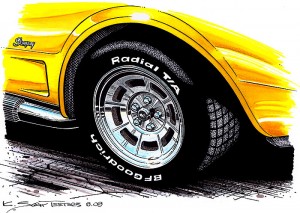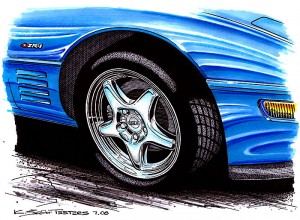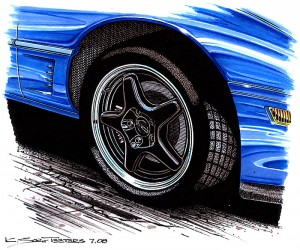Dateline: 7.10.2011
A Historic Look Back at the Wheels that Vettes Ride On!
1968 was a major turning point in the Corvette story with the introduction of the Mako Shark II-inspired C3 Corvette. The Mako Shark II was first unleashed as a Chevrolet show car to test the market’s feelings towards the radically styled “futuristic” Corvette. The response was thunderous and the all-new body design and interior was fast-tracked into production. But making a show car into a real car is no easy task. The C3 was supposed to be introduced as a ‘67 model but wasn’t ready in time. The basic chassis and drive train was a carry-over from the ‘63 – ‘67 Sting Ray, which puts the suspension design date in the early ‘60s. At the time, no one imagined that the C3 would have a 15 year production run. Along the way, Corvette stylists kept the car fresh-looking with bumper cover, hood, fender vents, and wheels updates.
Despite the aging hardware, buyers made the Corvette a runaway success with a best-ever sales year in ‘79 with 53,807 units sold. The only other year that broke the 50K production figure was the ‘84 model with 51,547 units.
(To see larger versions of all of the below images, just click the image.)
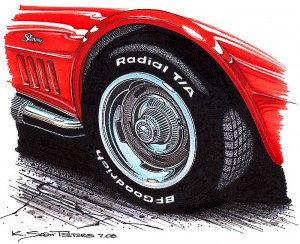
Your Basic, Slightly Wider Stamped Steel Wheel
The arrival of the ‘68 Corvette represented the most dramatic styling change in the history of the car. The change between the ‘67 and ‘68 Corvette was even more radical than the ‘62 to ‘63 styling change. Simply put, the new C3 was unlike anything else on the road. There were some comparisons to a few Ferrari and Maseratti cars, but those similarities were restricted to the sensuous fender curves and attitude.
Tailoring the Mako Shark II’s show car lines was not an easy task. It was reported that the biggest challenge was trimming down the Mako Shark II’s large front fender humps so that the driver could have a relatively clear view forward. Nearly the entire chassis and running gear was a carry-over from the ‘67 Corvette, including the base car’s wheel design. The 5-slotted, stamped steel Rally Wheel, with beauty rings and caps was a carry-over from the ‘67 design, but was one-inch wider. The new 15” x 7” wheel was the widest wheel to that date for the Corvette. The tire size was bumped up as well. The ‘67 wheel set road on 7.75” x 15” tires on 15” x 6” wheels. Beginning in ‘68, tires sizes were measures in “series” which represented the sidewall-to-width percentage ratio.
The ‘68 wheel set consisted of F70 x15 nylon tires on 15” x 7” wheels. The wider wheel-tire combo filled the new Shark-styled fenders nicely. The setup was the same as the ‘67 wheels – a silver painted steel wheel with a beauty ring and center cap. But the new beauty rings were thicker, giving the new design a deep-dish appearance.
By ‘69, muscle car mania was firmly in place with “muscle” options available for nearly every popular car from Detroit. While actual performance hardware was for the most part a carry-over from ‘68, the ‘69 Corvette was now wearing 15” x 8” steel wheels with chrome beauty rings and caps. Except for tire design and size, his wheel combination would remain the base Corvettes wheel set through to the end of the C3 line in ‘82.
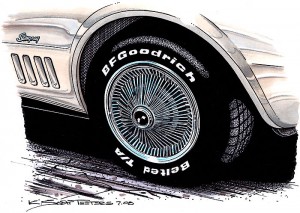
1968 – 1972 Wire Wheel-like Hub Cap
For buyers that preferred a slightly tamer appearance, the ‘68 model offered the “Bright Metal Wheel Cover” option for just 57.95. The following year the optional hub cap was called the “Deluxe Wheel Cover” option. This formal hub cap was a low-cost option from ‘68 to ‘73. Of the 163,913 Corvettes sold from ‘68 to ‘73, only 28,850, or 17.6% were wearing the optional hub caps. 1973 was the last year a full hub cap was ever offered on a Corvette.
The first time we saw this style wheel on a Corvette was at the 1970 New York Auto Show when Chevrolet debuted the XP-882 mid-engine Corvette concept car. Mid-engine sports cars were all the rage then, as they made it easy to achieve a balanced, 50/50 weight distribution – a much desired attribute for sports car design. The XP-882 morphed into the ‘73 4-rotor, mid-engine, Wankel-powered concept car. The early ‘70s wasn’t a happy time in Detroit and the GM bean counters decided that the current Corvette was selling just fine, so a completely new design was not needed.
However, the new slotted aluminum alloy wheels were approved for production and available as a $175 option in ‘73. While we take alloy wheels with tubeless tires for granted today, in ‘73, the new wheels proved to be a tricky design problem. The main issue was keeping air in the tires! “Officially,” the sales count for ‘73 option YJ8 was 4, but there are rumors that 800 sets were actually produced. The casting number on these very rare wheels is 329381. Unique to these wheels was the painted black recessed area around the lug nuts.
The alloy wheels became an on, then off, then on again Corvette option. The YJ8 optional alloy wheels was listed on the ‘74 order sheet, but records indicate that none were sold. Then in ‘75, the YJ8 alloy wheel option was missing from the Corvette order sheet. Finally in ‘76, with the YJ8 alloy wheel problems solved, aluminum alloy wheels were a for-real option for Corvette buyers for just $299.
The aluminum alloy wheels were extremely popular from ‘75 to ‘82. In ‘79 the optional wheels became option number N90. From ‘76 to ‘82, of the 289,720 Corvettes sold, 168,105, or 58% were wearing aluminum allow wheels.
The aluminum alloy wheels option was an important performance option for Corvettes. By ‘78, P255 / 60R15 tires were on the option list. As tire and wheel size increased, so did the total unsprung weight – that is, the amount of weight not being controlled with springs and shock absorbers. The reduction of unsprung weight equated to improved handling performance for those that liked taking their Corvette to the edge of it’s performance limits. Although most Corvette drivers never got that close to the car’s performance limit, part of what has always made Corvettes great is that higher than normal performance limits were built into the car for those that dare.
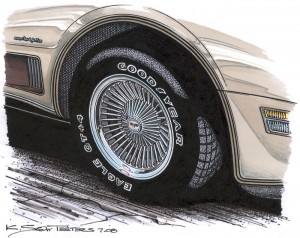
1982 Collector Edition Knock-off-like Wheels
1982 marked the end of a long road for the C3 Corvette. The car was in serious need of a major update. After all, the chassis design originated in 1960! With the new C4 design in the works, Corvette planners offered a special sendoff option for buyers in ‘82. The Collector Edition included everything except for big-block power and side pipes.
The ‘82 Collector Edition was a $4,247 option on top of the $18,648 base price of the Corvette. This car had several very unique options that were only available with the Collector Edition package. Most notably was the beige silver paint with the special graduated black graphics on the hood and the sides coming out of the front fender vents and finned, and cast aluminum wheels that were a salute to the ‘63 knock off wheels. This was also the first production Corvette to break the $20,000 barrier.
Yes, sales were way off in ‘82. The economy was not good and the rumor mill was flush with projections and speculations about the upcoming, new C4 scheduled as a ‘84 model. Of the 25,407 Corvettes sold in ‘82, 6,759 (26.6%) were Collector edition cars. Another unique feature of the ‘82 Collector Edition was the frameless glass hatchback. This was a feature that can be seen in Corvette archive photos going back to preproduction images of the ‘63 Corvette Coupe that were taken sometime in ‘62!
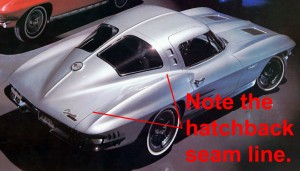
Yes, a 1963 Sting Ray Hatchback was proposed!
(Click the image to see a much larger version)
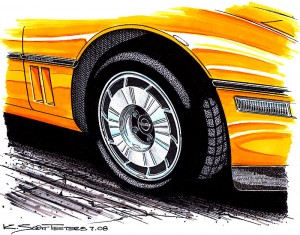
1984 – 1987 Stock Alloy Wheels
The all-new ‘84 C4 was the most radical Corvette redesign since the introduction of the C2 ‘63 Sting Ray. The Crossfire Injection 350 engine was the only carryover from the ‘82 model, while everything else was completely new. There was no fire-breathing engine option, but the Z51 suspension option delivered skid-pad numbers that were on par with race cars of the day – over 1G. The down side was that living with a Z51 optioned Corvette was a prescription for having your dental filling replaced. On real-world streets, the car was way too harsh.
The overall design followed the “form follows function” theory of design. For instance, the front fender humps were toned down considerably from the C3 Shark design to improve forward visibility. Nearly every aspect of the car was designed this way. The aluminum alloy wheels had several very unique design features. The wheels were designed to have a right and left side, such that as the wheels turned, the vanes around the center hub button, functioned as exhaust fans to pull in air from inside the wheel wells to cool the disc brakes.
The P255 / 50VR16 wheel set was coded as option QZD costing $561, and was supposed to be included in the Z51 package. It turned out that all ‘84 Corvettes used the new larger wheel / tire combination. The “V” rating on the tires meant that the tires were capable of sustaining very high speeds without flying apart. This was the first time a Corvette had truly high-performance tires as standard equipment.
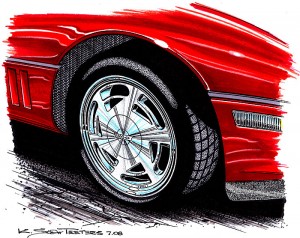
1988 – 1990 Stock Alloy Wheels
1988 was another landmark year for the Corvette. To celebrate the car’s 35th anniversary there was the $4,795 35th Special Edition option. The wheels of the base Corvette were redesigned in a 6-spoke configuration. Size was the same as the previous C4 wheels, 16×8.5. But included with the Z51 Performance Handling Package were wheels that looked similar like the stock alloy wheels, but measured 17×9.5 with 12 cooling slots, wearing Goodyear Eagle P275/40ZR17 tires, rated at 149+mph.
This was the beginning of a trend of ever improving standard and optional tires for Corvettes. Every few years, the wheel / tire combo gets a little larger in diameter and width, and is wearing increasingly higher performance tires to keep up with the Corvette’s upwardly creeping top speed. Again, the underlying thinking in Corvette design was to build in more performance capability than most drivers will ever extract, but is there for those that dare.
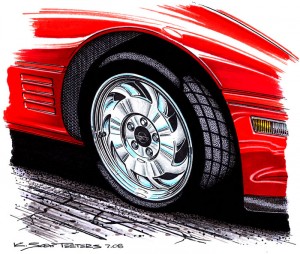
1991 – 1996 Stock Allow Wheels
The base Corvette wheels were the same size as the ‘90 wheels – 17” x 9”, but the fan-blade design was different. The six-spoke, 12 slot design was replaced with a 8-blade design that surrounded a center hub button similar to the ‘84 to ‘87 design. This design was first seen on the mid-engine ‘86 Indy Corvette clay model, on the ‘88 functional Indy Corvette, and then on the ‘90 CERV III engineering study, which was the last of the mid-engine Corvette prototypes.
From a performance standpoint, the wheel / tire combination was now right were it needed to be. We are looking at lightweight aluminum allow wheels wearing tires that were better than racing tires of a decade before. The built-in directional fan design not only looked good, but helped cool the disc brakes and extract brake dust. What was included in the stock Corvette was the stuff of day dreams not long before.
Meanwhile, Chevy’s Corvette supercar, the optional ZR-1 was wearing wheels that looked just like the stock Corvette’s, but were 11-inches wide on the rear wheel set. Starting in ‘90, ZR-1 Corvettes road on Goodyear Z-rated P315 / 35ZR17 tires – the widest wheel / tire combo ever offered on a Corvette to that date. These wheels were a ZR-1 exclusive and were not part of the new Z07 Adjustable Suspension Package that replaced the previous Z51 option. The Z07 package included all of the Z51 parts, plus the new FX3 Selective Ride and Handling Package.
I suppose it’s just human nature to complain about something. One of the very few complaints about the stunning ZR-1 Corvette option was that it didn’t look very much different from a regular Corvette. Chevy changed that in ‘94 with a new set of non-directional, 5-spoke, mag-type wheels. The size of the wheel / tire combo was the same, but the new thin-spoke design gave the ZR-1 a lighter look. The new mag-style wheels were only available with the ZR-1 for ‘94.
However, in ‘95 Indy 500 Pace Car Replica wore the same 5-spoke design wheel but in the standard 17 x 9.5-inch size. We should also note that ‘95 was the last year for the ZR-1 with only 448 units built for the year. The 5-spoke design wheels showed up on two more special edition Corvettes, but were never a stand alone option available on all new Corvettes through to the end of the C4 production run.
The end of the C4 production run went out with a bang. There were two special edition Corvettes in ‘96. The Collector edition was a very nice collection of special Sebring Silver paint, dedicated emblems, special details on the brake rotors, exterior embroidery, and painted silver ZR-1-style 5-spoke mag wheels. Available as a coupe or roadster, the ‘96 Collector Edition was an affordable $1,250 option with 5,412 units produced.
And for Corvette buyers longing for something more racy, there was the $3,250 Grand Sport Package. This was a salute to what is arguably the greatest “could have been great” racing Corvettes ever made. While Duntov was only able to sneak out 5, ‘63 Grand Sport Corvettes (he was planning on making at least 100 for homologation) Chevy dished up 6,412 ‘96 Grand Sport coupes and roadsters.
The package included exclusive Admiral Blue paint and white stripe, special interior embroidery, the same detailed brake rotors as the Collector Edition, and special black spoke ZR-1 wheels. Yes, the same 11-inch wide rear wheels that the last ‘95 ZR-1 wore. All ZR-1 Corvettes had special, extra wide rear fascia, fenders, and doors to cover its huge rear tires. Rather than carry the extra weight of the complete ZR-1 body package, the Grand Sport features a unique, rear fender flair arch, just above the car’s beltline. The tie back was to the distinctive rear fender flares used on the ‘63 Grand Sport racing Corvettes.
The complete package was stunning and makes for quite a sight at Corvette car shows when all of the attending ‘96 Grand Sports are gathered together. It’s a beautiful thing to see. – Scott
PS – This article was originally published in the January 2009 issue of VETTE Magazine. You can catch Pt. 1 of this 3-part feature article HERE.
And Part 3 of this series is HERE.
[nggallery id=16]


